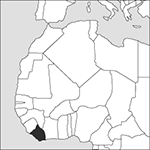
Source: MAPS IN MINUTES™ © RH Publications (1997)
Capital:
Monrovia
Area:
111,369 sq km (43,000 sq miles)
Population:
3,989,703 (2013 est)
Currency:
1 Liberian dollar = 100 cents
Religions:
Christian 85.6%; Muslim 12.2%; traditional beliefs 0.2%
Ethnic Groups:
Kpelle 20.3%; Bassa 13.4%; Grebo 10.0%; Gio 8.0%; Mano 7.9%; Kru 6.0%; Lorma 5.1%
Languages:
English (official); indigenous languages
International Organizations:
UN; AU; ECOWAS; Non‐Aligned Movement
A tropical country on the Atlantic coast of West Africa, flanked by Sierra Leone, Guinea, and Côte d’Ivoire.
Physical
The climate is hot and very wet. Rainforest and swamp cover the coastal plain, which is traversed by several rivers flowing down from savannah‐covered uplands.
Economy
Liberia’s economy was wrecked by the 1990–2005 civil war, but has since begun to recover under the stimulus of rubber, iron ore, timber, and diamond exports. Other important exports are cocoa and coffee. The large agricultural sector also produces rice, cassava, and palm oil, and most industry involves processing of agricultural products.
History
Liberia is the oldest independent republic in Africa (1847). It owes its origin to the philanthropic American Colonization Society. US negotiations with local rulers for a settlement for the repatriation of freed slaves began in 1816. The first settlements were made in 1822, and the name Liberia was adopted in 1824. Independence was proclaimed by Joseph Jenkins Roberts, first President, in 1847. The real beginning of prosperity was in the 1920s, when the Firestone Rubber Company provided a permanent and stable market for rubber. W. V. S. Tubman was President from 1944 until his death in 1971. With a decline in world rubber prices, the economy suffered in the 1970s and a bloody revolution in 1980 brought in the People’s Redemption Council, a military government, under Master‐Sergeant Samuel Doe. The latter was named President and Commander‐in‐Chief, and his ten‐year autocratic rule was one of deep corruption, ending in 1990 with civil war. Two rebel groups, one led by Charles Taylor and a second by Prince Yormie Johnson, assailed the capital Monrovia. A peacekeeping force from ECOWAS intervened, Doe was murdered, and a ceasefire arranged in 1990. Peace agreements were made in 1991, 1993, and 1995 but did not end the fighting between rival factions. However, progress was made: a transitional legislature was set up in 1994, and Charles Taylor was elected President in 1997. Rebels forced him into exile in 2003, after which a multinational peacekeeping force was deployed and a transitional government established. In 2012, at the International Criminal Court Taylor became the first former head of state to be convicted of crimes against humanity. Ellen Johnson Sirleaf was elected President in 2005, becoming Africa’s first woman leader. Her government worked to rebuild Liberia’s shattered economy and infrastructure, and a Truth and Reconciliation Commission was established in 2006. She was re-elected in 2011. In March 2014, the first cases of Ebola fever were reported. Efforts to restrict the movement of people in infected areas failed to contain the epidemic, which overwhelmed the country's medical services. By mid 2015, 4,800 people had died, with some further deaths before Liberia was declared free of Ebola in 2016.
- Guiscard, Robert (1015–85)
- Guise
- Guizot, François Pierre Guillaume (1787–1874)
- Gujral, Inder Kumar (1919–2012)
- Guldberg, Cato Maximilian
- Guldberg rule
- Gulfian
- Gulf Stream
- Gulf War (1991)
- gull
- gullet
- gulling
- Gullstrand, Allvar
- gully
- gulp
- gum
- Gumbel distribution
- Gumbel, Emil Julius (1891–1966)
- Gum Nebula
- gun
- gunboat diplomacy
- guncotton
- Gunflint Chert
- gun metal
- Gunn diode